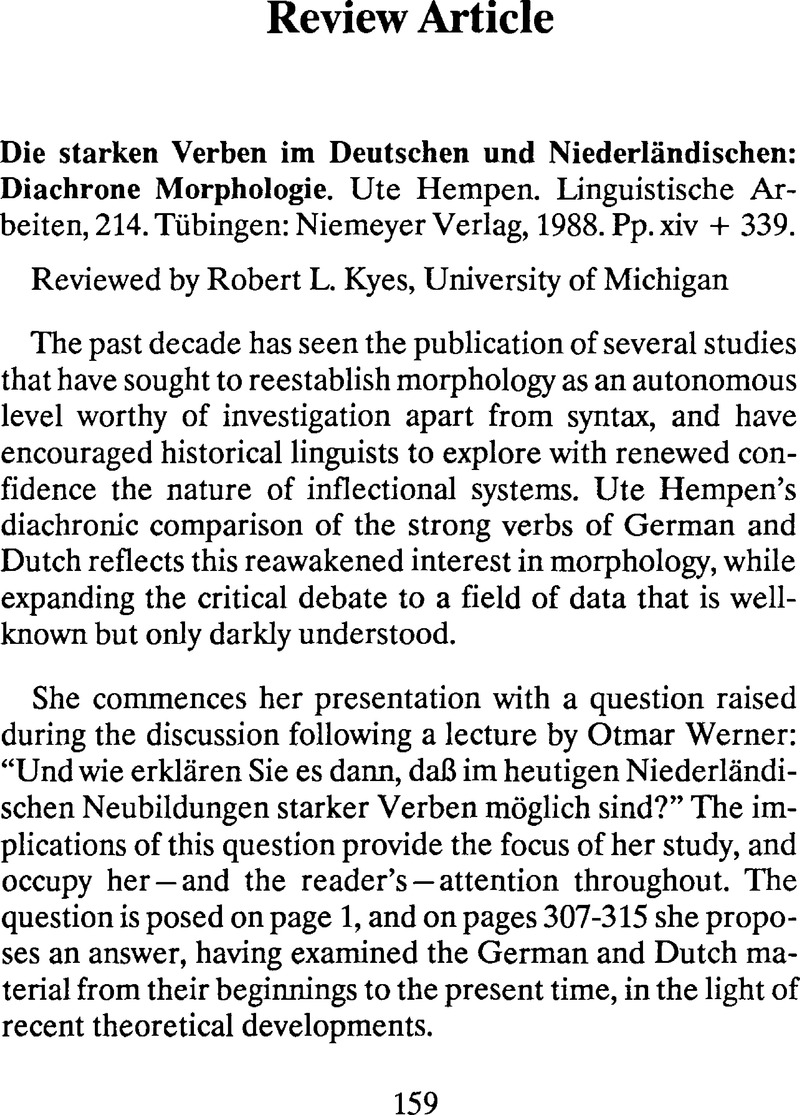No CrossRef data available.
Article contents
Die starken Verben im Deutschen und Niederländischen: Diachrone Morphologie
Published online by Cambridge University Press: 05 December 2008
Abstract
An abstract is not available for this content so a preview has been provided. Please use the Get access link above for information on how to access this content.

- Type
- Review Article
- Information
- Copyright
- Copyright © Society for Germanic Linguistics 1990
References
WORKS CITED
Braune, Wilhelm. 1987. Althochdeutsche Grammatik. 14th ed. Ed. Eggers, Hans. Tübingen: Niemeyer.Google Scholar
Bybee, Joan. 1985. Morphology: A study of the relation between meaning and form. Amsterdam: Benjamins.CrossRefGoogle Scholar
Coetsem, Frans van. 1980. “Germanic verbal ablaut and its development: A contribution to the theory of internal inflection.” Contributions to historical linguistics. Ed. van Coetsem, Frans and Waugh, Linda R.. Leiden: Brill. Pp. 281–339.Google Scholar
Drosdowski, Günther. 1984. Duden. Grammatik der deutschen Gegenwartssprache. 4th ed.Mannheim: Bibliographisches Institut.Google Scholar
Helten, Willem Lodewijk van. 1969. Die altostniederfränkischen Psalmenfragmente, die Lipsius'schen Glossen und die altsüdmittelfränkischen Psalmenfragmente. New York: Johnson. Rpt. of Groningen: Wolters, 1902.Google Scholar
Kern, Peter Christian, and Herta, Zutt. 1977. Geschichte des deutschen Flexionssystems. Tübingen: Niemeyer.Google Scholar
Kyes, Robert L. 1967. “The evidence for i–umlaut in Old Low Franconian.” Language 43:666–673.CrossRefGoogle Scholar
Lexer, Matthias. 1872–1878. Mittelhochdeutsches Handwörterbuch. 3 vols. Leipzig: Hirzel.Google Scholar
Lexer, Matthias. 1969. Mittelhochdeutsches Taschenwörterbuch. 33rd ed.Stuttgart: Hirzel.Google Scholar
Paul, Hermann. 1982. Mittelhochdeutsche Grammatik. 22nd ed. Eds. Moser, Hugo, Schröbler, Ingeborg, and Grosse, Siegfried. Tübingen: Niemeyer.Google Scholar
Rauch, Irmengard et al. , 1988. “Is there an aspect distinction in certain German strong/weak alternations? Evidence from German in the San Francisco Bay area.” Semper idem et novus: Festschrift for Frank Banta. Ed. Gentry, Francis G.. Göppingen: Kümmerle. Pp. 433–443.Google Scholar
Weinhold, Karl. 1967. Mittelhochdeutsche Grammatik. Paderborn: Schöningh. Rpt. of ed. of 1883.Google Scholar
Wurzel, Wolfgang. 1984. Flexionsmorphologie und Natürlichkeit. Berlin: Akademie der Wissenschaften.Google Scholar




